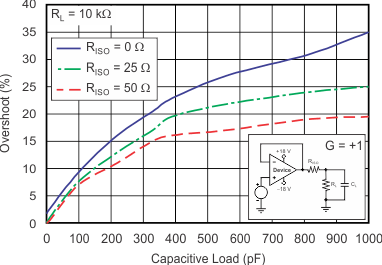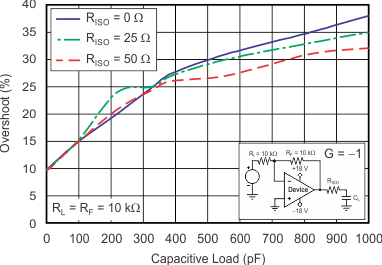JAJSD62C March 2013 – January 2020 OPA188
PRODUCTION DATA.
- 1 特長
- 2 アプリケーション
- 3 概要
- 4 改訂履歴
- 5 Device Comparison Table
- 6 Pin Configuration and Functions
- 7 Specifications
- 8 Detailed Description
- 9 Application and Implementation
- 10Power Supply Recommendations
- 11Layout
- 12デバイスおよびドキュメントのサポート
- 13メカニカル、パッケージ、および注文情報
パッケージ・オプション
メカニカル・データ(パッケージ|ピン)
サーマルパッド・メカニカル・データ
- DGK|8
発注情報
8.3.6 Capacitive Load and Stability
The device dynamic characteristics are optimized for a range of common operating conditions. The combination of low closed-loop gain and high capacitive loads decreases the amplifier phase margin and can lead to gain peaking or oscillations. As a result, larger capacitive loads must be isolated from the output. The simplest way to achieve this isolation is to add a small resistor (for example, ROUT equal to 50 Ω) in series with the output. Figure 41 and Figure 42 show graphs of small-signal overshoot versus capacitive load for several values of ROUT. For details of analysis techniques and application circuits, see Feedback Plots Define Op Amp AC Performance, available for download from www.ti.com.

| G = 1 | RL = 10 kΩ | 100-mV Output Step |

| G = –1 | RL = RF = 10 kΩ | 100-mV Output Step |